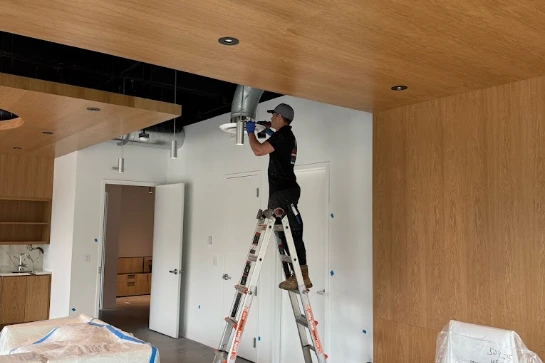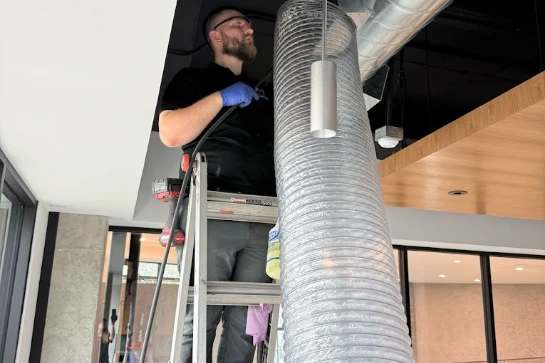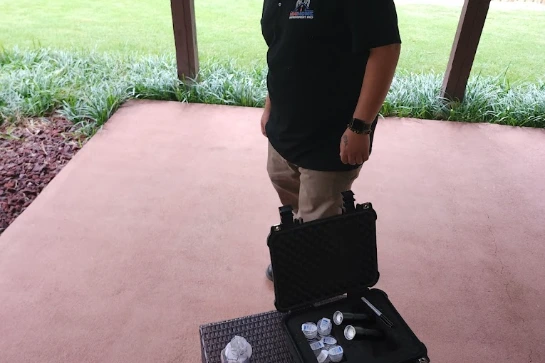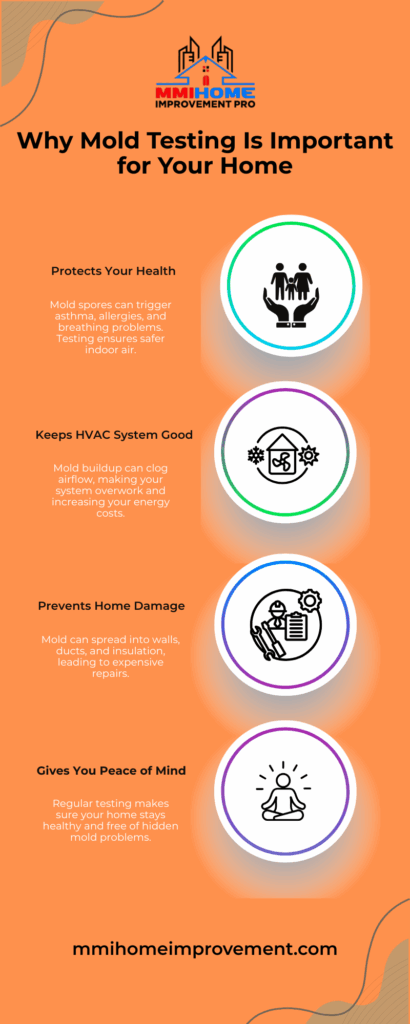I still remember the day my uncle found mold in the HVAC system. He came home from work, noticing a strange, musty smell that wasn’t there before. At first, he thought it was just the weather, but soon his health issues and energy bills increased. Curious and concerned, he decided to test his HVAC system for mold.
That decision not only saved him from costly repairs but also made his home a much healthier place to live. Here, I’ll share the step-by-step process my uncle followed and provide you with expert tips on how to test for mold in the HVAC system, making sure of a safer and more efficient home environment. If you’re looking to book appointment for mold air duct cleaning in Smyrna and nearby areas, trust MMI Home Improvement Pro.

Why Testing for Mold in HVAC System is Important
Mold grows best in moist, dark places, and your HVAC System is the perfect spot to grow. Over time, moisture, dust, and dirt build up in your air ducts, creating the conditions for mold to grow. However, testing for mold in your HVAC system is important for several reasons.


Why Mold Testing Is Necessary
- Protects Your Health: Mold releases tiny spores into the air, which can cause allergies, asthma, and breathing problems. Testing helps keep your air safe.
- Keeps Your HVAC System Good: Mold buildup can block airflow, making your system work harder and increasing energy bills.
- Prevents Home Damage: Mold can spread to walls, insulation, and ductwork, causing costly repairs.
- Gives You Peace of Mind: Regular testing makes sure your home stays healthy and free of hidden mold problems.
Signs of Mold in HVAC System
Before testing for mold, watch for these warning signs.
- Dark Patches: If you see black or green spots inside your air vents or around your HVAC unit, mold might be present.
- Musty Smell: A moldy or stale odor when your HVAC system is running is a strong sign of mold growth.
- Increased Allergy Symptoms: If you or your family are sneezing, coughing, or having itchy eyes indoors, mold could be the cause.
- Moisture: Too much moisture around your HVAC system can cause the perfect environment for mold.
Read Also: What is the difference between non-toxic and toxic mold?
How to Test for Mold in HVAC System
You can test for mold yourself or hire a professional.
1. Do a Visual Inspection
What You Need: A flashlight, gloves, a mask, and a ladder.
- Turn off the System: You should always shut down your HVAC system before inspecting it.
- Check Key Areas: Look for mold inside air ducts, filters, coils, and around the air handler.
- Take Pictures: If you see suspicious spots, take photos to compare later or show a professional.
2. Use a Mold Testing Kit
Mold testing kits can help you check for mold spores in your HVAC system.
How It Works:
- Collect Samples: Follow the kit instructions to gather air or surface samples.
- Send to a Lab: Some kits require mailing samples for lab analysis. Others have a color-changing indicator.
- Review the Results: Compare the results with the guide included in the kit. If mold is present, take action.
3. Try Air Quality Testing
For a more accurate test, consider professional air sampling.
What a Professional Will Do:
- Use Special Equipment: They will take air samples and check for airborne mold spores.
- Provide a Report: The results will show how much mold is in your system and whether action is needed.
4. Swab Test for Surfaces
A swab test helps check specific areas inside your HVAC system.
How to Do It:
- Choose a Spot: Pick an area that looks damp or discolored.
- Swab the Surface: Gently wipe the area with a sterile swab.
- Send It for Testing: A lab will analyze the sample to confirm the type of mold.

Use the below code to embed this infographic
5. Hire a Professional Mold Inspector
Sometimes, the safest and best option is to call in a mold expert.
Benefits of a Professional Inspection
- Find Hidden Mold: Experts use advanced tools to locate mold you can’t see.
- They Provide a Detailed Report: You’ll get a full breakdown of the mold problem and the next steps.
- Offer Safe Removal Advice: Professionals know how to remove mold safely.
What Do Your Mold Test Results Mean?
- Low Mold Levels: No major issues, but regular HVAC cleaning is still a good idea.
- High Mold Levels: You need to take action right away to prevent health problems.
- Mold Type Identified: Some molds are more dangerous than others. Knowing the type helps decide how serious the problem is.
What to Do if You Find Mold
If mold is detected in your HVAC system, act fast!
1. Turn Off Your HVAC System: Shutting it down stops mold spores from spreading through your home.
2. Block Off Affected Areas: Seal off the problem areas to prevent further contamination.
3. Call a Professional Mold Removal Service: Experts can clean your system properly and safely.
4. Improve HVAC Maintenance:
- Clean Filters Regularly: Change or clean air filters every 1–3 months.
- Reduce Moisture: Use a dehumidifier to keep humidity levels low.
- Schedule Inspections: Have your HVAC system checked by a professional at least once a year.
For detailed insight, read our previous article Does Hard Floor Drying Prevent Mold Growth?
How to Prevent Mold in HVAC System
The best way to deal with mold is to prevent it from growing in the first place!
- Clean Your HVAC System: Get your ducts, coils, and filters cleaned regularly.
- Fix Leaks Quickly: Water leaks create the perfect conditions for mold.
- Improve Air Circulation: Use fans or open windows to keep air moving.
- Upgrade Your HVAC System: If your system is old, consider upgrading to one with better moisture control.
Summary
Mold in the HVAC system is a serious issue. It can make you sick, raise energy bills, and even damage your home. Regular testing for mold helps catch problems early and keeps indoor air clean. Whether you choose a DIY test or hire a professional, acting fast is key. Follow the steps in this guide to test, remove, and prevent mold in your HVAC system. A little maintenance goes a long way in keeping your home safe and healthy!

